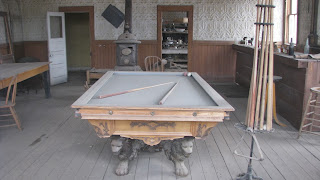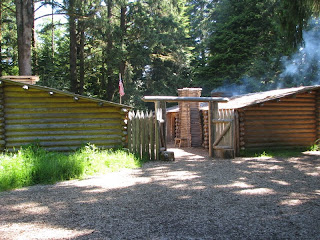October 6-7, 2013, Bridgeport, CA
We left Carson City Sunday morning and headed south into
Northeastern California. We drove to
Bridgeport, CA and are staying at Paradise Shores RV Park on Bridgeport
Reservoir. This area of California is
where the Sierras meet the Great Basin.
We have a great view of the Sierras from our campsite. This small RV park was also once a marina but
the lake is so low that you have to walk about ¼ mile to the water.
We received an e-mail from our bank that a fraud alert has
been put on our credit card. When we
called the bank we found out that two attempts to use our card at clothing
stores in Cancun, Mexico were denied.
So we now join everyone else who have had their credit card number
stolen. We know that because we travel
so much we are fortunate that it has not happened sooner. We are also thankful that our credit card
company is so vigilant and denied the charges in Mexico. We are suspicious that the cc number was
stolen at the gas station at Silver City RV – we think we will avoid Carson
City, or at least Silver City RV, in our future travels.
After lunch we loaded the dogs in the Jeep and took a 4-wheel drive into the eastern Sierras on Masonic Mountain to the ghost town of Masonic. Along the way we were surprised to see so many aspen trees among the sagebrush. The fall colors were beautiful.
We
stopped at the ruins of the Chemung Mine and walked around looking at the mine
and surrounding buildings. This mine was
started in 1909 and was worked into the 1960’s but was not a consistent
producer.
There isn’t much left at Masonic except the ruins of the Pittsburg-Liberty
Stamp Mill and a few foundations. This
town had over 1,000 residents at one time.
Prospectors discovered gold here in the 1860s and many of the workers
were masons, hence the name. In 1900 a
16 year old boy from nearby Bodie found rich ore in the gulch and staked his
claim as the Jump Up Joe Mine. Several
other rich strikes were discovered and production peaked between 1906 and
1911. Depleting ore veins, lawsuits,
mill breakdowns and rising shipping ended the boom and by 1950 the town was
completely deserted.
We took a short hike through a large aspen grove before we
headed back to the RV park.
Monday we packed a picnic lunch, loaded the dogs in the Jeep
and headed to Bodie State Historical Park.
Waterman S. Body discovered gold here in 1859 and by 1879 Bodie had a
population of about 10,000. The citizens
changed the spelling of the town name to ensure proper pronunciation. The Bodie Mining District was formed in 1860
and by 1942 had produced close to $100 million in gold and silver.
Bodie
was designated a state historic park in 1962 and is maintained in a state of
“arrested decay”. You can walk around and look in the windows
but are not allowed in any of the buildings except the museum.
The
houses are left as they were found with stained and peeling wallpaper,
scattered furniture and lots of dust and dirt.
A
few things have been restored like these gas pumps and truck.
This beautiful ornate coffee grinder was in the general
store along with shelves of old products.
It would have been nice to get into this store to see what was actually
on the shelves.
Bodie had over 60 saloons and dance halls and a reputation
for wickedness, badmen and the worst climate out of doors.
This ornate pool table in one of the saloons caught our eye
– notice the lion’s heads carved on the legs.
Some of the buildings are ready to fall down – this one is
being propped up with a log.
The small museum is located in the old Miners Union Hall and
had some great displays like this beautiful horse drawn hearse. They also had lots of items that were found
in the Bodie houses. There was a great
display of old photos - they are asking the public for help in identifying the
people in the photos. They also have a
couple of large paintings that were painted by two women who lived in Bodie.
Bodie
has two bad fires that destroyed most of the town, one in 1892 and another in
1932. The Bodie Bank escaped the fire
in 1892 but was destroyed in the fire of 1932.
All that is left is the remains of the vault.
The mill at the Standard Mine operated on steam power and
used over 40 cords of wood a day. The
mill superintendent convinced a major stockholder to invest in electric power
transmitted 13 miles over wires from a hydroelectric plant on Green Creek. In 1892, Bodie was the first town in the
world to operate equipment and lighting using electricity brought in over
long-distance transmission lines. This
mill last operated in 1938.
By 1881 the mines were largely depleted and by 1886 the
population had shrunk to about 1500. We
couldn’t find any information about when the last residents left Bodie but
guess in must have been in the 1950s around the same time Masonic was deserted. We enjoyed walking around this great ghost
town and getting a glimpse of what life was like in the late 1800s and early
1900s.
The
aspen groves here are smaller than what we are used to in Colorado but the
colors are beautiful.
On
the way back to the RV park we passed Mono Lake. As we climbed Conway Summit we stopped at a
scenic overlook and got a great view of the lake. The signs at the overlook told about what
happened to the lake when LA started diverting water from the rivers and
streams that feed the lake - the water level dropped around 50% in ten
years. The water level has risen some
since then but as seen in this picture is still very low. This is a very alkaline lake and is a haven
for migrating birds.
We
enjoyed our visit to Bodie and the beautiful drive in Lundy Canyon.




















.JPG)
Comments
Post a Comment